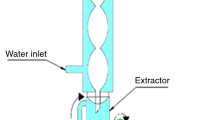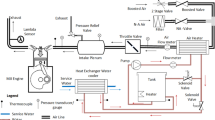Abstract
It is well known that acetylene has a wide flammability and is readily available and low-cost non-crude oil derivative fuel. According to the property of low motor octane number, the acetylene cannot be used alone in the internal combustion engine. Research has shown that the introduction of biodiesel results in a substantial reduction in the use of conventional fossil fuels and also in the amount of emissions. This study focuses on performance improvement and emission reduction of conventional diesel engine using acetylene gas as a low-reactivity fuel (LRF) and B20 mahua biodiesel as a high-reactivity fuel (HRF) in the reactivity controlled compression ignition (RCCI) mode. The computational fluid dynamics (CFD) principle is used to evaluate the optimal angle of the LRF injector to achieve better fluid flow mixing pattern in the inlet manifold. From the CFD simulation, an optimal LRF injection angle of 45° is defined in the intake manifold. The modified intake manifold engine is tested for performance, emission and combustion characteristics at different flow rates of acetylene through the injector. It is observed that the brake thermal efficiency (BTE) is increased by about 3.7% at a flow rate of 4 liters per minute (LPM) of acetylene injection in RCCI combustion mode compared to conventional biodiesel operation and significant decreases in polluting components such as smoke opacity, oxides of nitrogen (NOx), hydrocarbon (HC) and carbon monoxide (CO) are reduced by about 10%, 7.6%, 13.4% and 28.7%.
Graphic abstract





















Similar content being viewed by others
References
Alagumalai A (2020) Reduced smoke and nitrogen oxide emissions during low-temperature combustion of ethanol and waste cooking oil. Environ Chem Lett 18(2):511–516
Basha S, Rao P, Rajagopal K, Kotturi R (2017) Design and analysis of swirl in acetylene aspirated diesel engine and its effects on performance & emissions. Int J Latest Trends Eng Technol 8(2):390–399
Brusca S, Lanzafame R, Garrano AMC, Messina M (2014) On the possibility to run an internal combustion engine on acetylene and alcohol. Energy Procedia 45:889–898
Bryant DB, Sparrow EM, Gorman JM (2018) Turbulent pipe flow in the presence of centerline velocity overshoot and wall-shear undershoot. Int J Therm Sci 125:218–230
Cebula A, Świątek P, Kowalczyk S (2019) A numerical analysis of the air flow through the IC engine intake manifold. Progress Comput Fluid Dyn Int J 19(1):63–68
Charitha V, Thirumalini S, Prasad M, Srihari S (2019) Investigation on performance and emissions of RCCI dual fuel combustion on diesel-biodiesel in a light duty engine. Renewable Energy 134:1081–1088
Chintala V, Subramanian KA (2013) A CFD (computational fluid dynamics) study for optimization of gas injector orientation for performance improvement of a dual-fuel diesel engine. Energy 57:709–721
De Souza GR, de Castro Pellegrini C, Ferreira SL, Pau FS, Armas O (2019) Study of intake manifolds of an internal combustion engine: a new geometry based on experimental results and numerical simulations. Thermal Sci Eng Progress 9:248–258
Deivajothi P, Manieniyan V, Sivaprakasam S (2018) An impact of ethyl esters of groundnut acid oil (vegetable oil refinery waste) used as emerging fuel in DI diesel engine. Alexandria Eng J 57(4):2215–2223
Deivajothi P, Manieniyan V, Sivaprakasam S (2019) Experimental investigation on DI diesel engine with fatty acid oil from by-product of vegetable oil refinery. Ain Shams Eng J 10(1):77–82
Dhas AG, Arul Gnana Dhas A, Devarajan Y, Nagappan B (2018) Analysis of emission reduction in ethyne–biodiesel-aspirated diesel engine. Int J Green Energy 15(7):436–440
Dimitriou P, Tsujimura T (2017) A review of hydrogen as a compression ignition engine fuel. Int J Hydrogen Energy 42(38):24470–24486
Duraisamy G, Rangasamy M, Govindan N (2020) A comparative study on methanol/diesel and methanol/PODE dual fuel RCCI combustion in an automotive diesel engine. Renew Energy 145:542–556
Ebrahimi M, Jazayeri SA (2019) Effect of hydrogen addition on RCCI combustion of a heavy duty diesel engine fueled with landfill gas and diesel oil. Int J Hydrogen Energy 44(14):7607–7615
Jemni MA, Kantchev G, Abid MS (2011) Influence of intake manifold design on in-cylinder flow and engine performances in a bus diesel engine converted to LPG gas fuelled, using CFD analyses and experimental investigations. Energy 36(5):2701–2715
Kanawade N, Siras O (2015) Design, analysis, and development of 4-cylinder IC engine exhaust manifold. Int Eng Res J 6(1):472–478
Kokjohn S, Hanson R, Splitter D, Kaddatz J, Reitz R (2011) Fuel reactivity controlled compression ignition (RCCI) combustion in light-and heavy-duty engines. SAE Int J Eng 4(1):360–374
Lakshmanan T, Nagarajan G (2010) Experimental investigation of timed manifold injection of acetylene in direct injection diesel engine in dual fuel mode. Energy 35(8):3172–3178
Li Y, Jia M, Chang Y, Xu Z, Xu G, Liu H, Wang T (2018) Principle of determining the optimal operating parameters based on fuel properties and initial conditions for RCCI engines. Fuel 216:284–295
Manieniyan V, Sukumar V, Senthilkumar R, Sivaprakasam S (2019). Emission reduction using biodiesel blends with nano-additives and reformed exhaust gas recirculation (REGR) in DI diesel engine. Int J Ambient Energy 1–7
Moffat RJ (1988) Describing the uncertainties in experimental results. Exp Thermal Fluid Sci 1(1):3–17
Murugesan A, Subramaniam D, Avinash A, Nedunchezhian N (2015) Quantitative and qualitative analysis of biodiesel–an in-depth study. Int J Ambient Energy 36(1):19–30
Nazemi M, Shahbakhti M (2016) Modeling and analysis of fuel injection parameters for combustion and performance of an RCCI engine. Appl Energy 165:135–150
No SY (2019) Application of bioethanol to advanced CI engines; dual fuel and RCCI combustion modes–a review. Int J Green Energy 16(14):1105–1130
Raman R, Kumar N (2019) The utilization of n-butanol/diesel blends in acetylene dual fuel engine. Energy Reports 5:1030–1040
Saravanakumar A, Avinash A, Saravanakumar R (2016) Optimization of biodiesel production from Pungamia oil by Taguchi’s technique. Energy Sources Part A Recovery Utilization Environ Effects 38(17):2524–2529
Schmidt DP, Rutland CJ (2000) A new droplet collision algorithm. J Comput Phys 164(1):62–80
Silambarasan R, Senthilkumar R, Manieniyan V, Sivaprakasam S (2017) Performance and emission analysis in DI diesel engine using biodiesel with bio additive. Int J Eng Trends Technol (IJETT) 4(5):865–868
Srivastava AK, Soni SL, Sharma D, Sonar D, Jain NL (2017) Effect of compression ratio on performance, emission and combustion characteristics of diesel–acetylene-fuelled single-cylinder stationary CI engine. Clean Technol Environ Policy 19(5):1361–1372
Subramaniam D, Murugesan A, Avinash A (2013) An inclusive view on biodiesel production by heterogeneous catalyst and its engine operational characteristics. J Renew Sustain Energy 5(3):033135
Sukumar V, Manieniyan V, Sivaprakasam S (2019) Experimental studies on DI diesel engine fueled in sweet lime pyrolysis oil with biodiesel. Int J Appl Eng Res 14(5):1145–1150
Sukumar V, Manieniyan V, Senthilkumar R, Sivaprakasam S (2020) Production of bio oil from sweet lime empty fruit bunch by pyrolysis. Renew Energy 146:309–315
Suryawanshi UK, Paikra AS, Mondloe D (2018) Comparative analysis of different type of biodiesel blend with diesel. Int Res J Eng Technol (IRJET) 5(9):406–413
Tirkey JV, Kumar A, Shukla SK (2018) Comparative analysis of engine performance and emission characteristics of different biodiesels. Biofuels, 1–9
Veerabadran V, Veerasigamani M, Shanmugam S (2020) Effect of carbon nanotube material in diesel engine with exhaust gas recirculation. Energy Sources, Part A: Recovery, Utilization, and Environmental Effects, pp 1–14
Wei T (2018) Integral properties of turbulent-kinetic-energy production and dissipation in turbulent wall-bounded flows. J Fluid Mech 854:449–473
Wu F, Wang J, Chen W, Shuai S (2009) A study on emission performance of a diesel engine fueled with five typical methyl ester biodiesels. Atmos Environ 43(7):1481–1485
Yang B, Duan Q, Liu B, Zeng K (2020) Parametric investigation of low pressure dual-fuel direct injection on the combustion performance and emissions characteristics in a RCCI engine fueled with diesel and CH4. Fuel 260:116408
Zheng Z, Xia M, Liu H, Wang X, Yao M (2018) Experimental study on combustion and emissions of dual fuel RCCI mode fueled with biodiesel/n-butanol, biodiesel/2, 5-dimethylfuran and biodiesel/ethanol. Energy 148:824–838
Author information
Authors and Affiliations
Corresponding author
Additional information
Publisher's Note
Springer Nature remains neutral with regard to jurisdictional claims in published maps and institutional affiliations.
Rights and permissions
About this article
Cite this article
Sonachalam, M., PaulPandian, P. & Manieniyan, V. Emission reduction in diesel engine with acetylene gas and biodiesel using inlet manifold injection. Clean Techn Environ Policy 22, 2177–2191 (2020). https://doi.org/10.1007/s10098-020-01968-y
Received:
Accepted:
Published:
Issue Date:
DOI: https://doi.org/10.1007/s10098-020-01968-y




